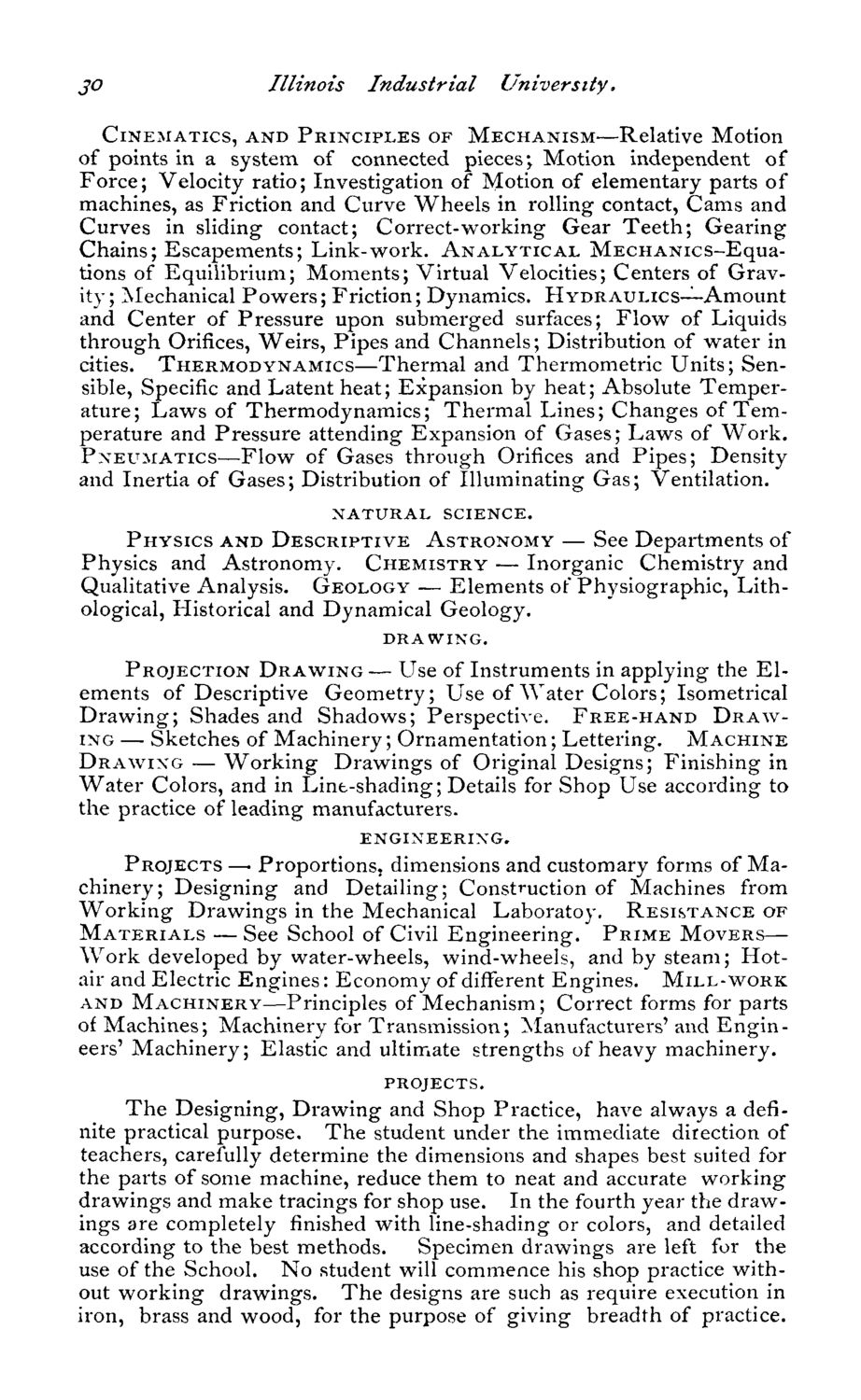Caption: Course Catalog - 1874-1875
This is a reduced-resolution page image for fast online browsing.

EXTRACTED TEXT FROM PAGE:
JO Illinois Industrial University, CINEMATICS, AND PRINCIPLES OF MECHANISM—Relative Motion of points in a system of connected pieces; Motion independent of Force; Velocity ratio; Investigation of Motion of elementary parts of machines, as Friction and Curve Wheels in rolling contact, Cams and Curves in sliding contact; Correct-working Gear Teeth; Gearing Chains; Escapements; Link-work. ANALYTICAL MECHANics-Equations of Equilibrium; Moments; Virtual Velocities; Centers of Gravity; Mechanical Powers; Friction; Dynamics. HYDRAULICS—Amount and Center of Pressure upon submerged surfaces; Flow of Liquids through Orifices, Weirs, Pipes and Channels; Distribution of water in cities. THERMODYNAMICS—Thermal and Thermometric Units; Sensible, Specific and Latent heat; Expansion by heat; Absolute Temperature; Laws of Thermodynamics; Thermal Lines; Changes of Temperature and Pressure attending Expansion of Gases; Laws of Work. PNEUMATICS—Flow of Gases through Orifices and Pipes; Density and Inertia of Gases; Distribution of Illuminating Gas; Ventilation. NATURAL SCIENCE. PHYSICS AND DESCRIPTIVE ASTRONOMY — See Departments of Physics and Astronomy. CHEMISTRY — Inorganic Chemistry and Qualitative Analysis. GEOLOGY — Elements of Physiographic, Lith- ological, Historical and Dynamical Geology. DRAWING. — Use of Instruments in applying the Elements of Descriptive Geometry; Use of Water Colors; Isometrical Drawing; Shades and Shadows; Perspective. FREE-HAND D R A W ING — Sketches of Machinery; Ornamentation; Lettering. MACHINE DRAWING — Working Drawings of Original Designs; Finishing in Water Colors, and in Lint-shading; Details for Shop Use according to the practice of leading manufacturers. PROJECTION DRAWING ENGINEERING. —• Proportions, dimensions and customary forms of Machinery; Designing and Detailing; Construction of Machines from Working Drawings in the Mechanical Laboratoy. RESISTANCE OF M A T E R I A L S — See School of Civil Engineering. P R I M E MOVERS— Work developed by water-wheels, wind-wheels, and by steam; Hotair and Electric Engines: Economy of different Engines. MILL-WORK AND MACHINERY—Principles of Mechanism; Correct forms for parts of Machines; Machinery for Transmission; Manufacturers' and Engineers' Machinery; Elastic and ultimate strengths of heavy machinery. PROJECTS PROJECTS. The Designing, Drawing and Shop Practice, have always a definite practical purpose. The student under the immediate direction of teachers, carefully determine the dimensions and shapes best suited for the parts of some machine, reduce them to neat and accurate working drawings and make tracings for shop use. In the fourth year the drawings are completely finished with line-shading or colors, and detailed according to the best methods. Specimen drawings are left for the use of the School. No student will commence his shop practice without working drawings. The designs are such as require execution in iron, brass and wood, for the purpose of giving breadth of practice.
|